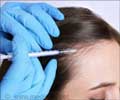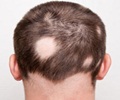Post-COVID recovery patients state a significant rise in unexpected hair loss – telogen effluvium that may be due to stress, nutritional deficiency, and inflammation.
- Massive influx of cases experiencing post-COVID hair loss has been reported at a Delhi hospital
- This sudden onset of hair loss is termed telogen effluvium
- Experts believe that nutritional deficiency, stress reactions, and inflammation in the patients are the main reasons for this post-COVID hair loss
- With proper treatment, the condition might improve within 2-3 months
Read More..
The Hair Cycle
Hair growth may appear like a simple daily process. However, our body consists of multiple processes to give rise to a single hair, depending upon age, nutrition, and overall health.The hair growth cycle consists of four distinct phases each having its timeline. The first three phases – anagen, catagen, and telogen are concerned with the growth and maturation of hair. It results in hair production.
The fourth stage – exogen involves the shedding of old hairs to make the new hair ready for replacement.
What is Telogen Effluvium?
The sudden onset of hair loss is termed telogen effluvium. It is generally a form of temporary hair loss that occurs on the top of the scalp as a result of stress, shock, or any traumatic event.It is recognized that the hairs may stop in the fourth – resting stage upon stress reactions and this may continue up to 2-3 months. After this, the hair starts shedding off – a classical mechanism of telogen effluvium, lasting up to even 4 months.
Normally, people tend to lose up to 100 hairs per day. However, in Telogen Effluvium, the count rises to 300-400 per day. It is different from the hair loss disorder called alopecia areata.
Surge in Cases
"We have seen a two-fold rise in the number of patients complaining of problems related to hair loss. Post COVID-19 inflammation has been a major contributor here. The deficiencies caused by a compromised nutritional intake, sudden changes in weight, hormonal disturbances and reduced vitamin D and B12 levels are some of the major reasons for the large volumes of hair loss post COVID-19," says Shahin Nooreyezdan, Senior Consultant, Cosmetic and Plastic Surgery, Indraprastha Apollo Hospitals, New Delhi.Losing the hair can itself trigger an emotional worry/upset among certain people. The ailment prevails between 1-1.5 months after the COVID recovery and is temporary. However, some patients may experience hair loss even during their COVID-19 illness.
What could Trigger this Hair Loss?
The alterations in dietary habits of the patients (low nutrition), weight loss, associated anxiety, abrupt hormonal changes, and persistent post-COVID-19 inflammatory reactions accompany almost every patient after the coronavirus infection.The experts thereby conclude that the surge in these post-COVID hair loss cases may be chiefly due to the nutritional deficiency, stress reactions, and inflammation in patients.
The good news is that the condition might improve with proper treatment in 2-3 months as per the health experts.
"Reason is the interruption of hair follicle growth due to an acute infection like COVID that pushes the hair into the shedding or dead phase (telogen phase). And the dead hair shed off after a few weeks automatically. For mild cases, recovery is automatic. In severe cases, a good hair supplement with biotin and amino acids, iron and other minerals is given, along with a peptide containing serum," says Sachin Dhawan, Senior Consultant, Department of Dermatology, Fortis Memorial Research Institute.
What could be Done to Prevent this?
COVID undoubtedly provokes an enormous amount of stress that would trigger telogen effluvium. Certain measures that may help reduce or prevent post-COVID hair loss complications include the following:- It is recommended to consume a healthy nutritious diet along with natural edible sources of vitamins (including vitamin D and B12), lots of proteins, and iron during the post-COVID-19 recovery phase.
- Sources like eggs, chicken, fish, green leafy vegetables, yogurt, soybean, and paneer may serve the needs of nutrients.
- Iron deficiency may itself accelerate further hair loss. Hence one may also opt for a nutritional supplement to aid the demands of the body.
- Apart from following these dietary rules, one must also avoid aggressive hairstyling equipment, heat, and chemicals for hair.
- Evade from a sedentary lifestyle and engage in regular exercise to promote circulation and body functions.
- Opt for mild, paraben, and sulphate free shampoos.
- Regularly check your head for the itchy and flaky scalp; Use a wide-tooth comb.
- Refrain from oiling and massaging the scalp
- Avoid stress; engage in relaxation techniques like meditation.
- Have a proper sleep everyday
- If the hair loss prevails for more than 5-6 weeks, despite taking all the necessary measures, it is advised to consult a doctor.
Hair Facts
- Hair on average grows between 0.5 and 1.7 centimeters (0.2 to 0.7 inches) per month.
- Generally, humans are born with approximately 5 million hair follicles.
- Among these, there are 100,000 follicles just on the scalp.
- Males may find their hair to grow faster than that of females.
- The shape of your hair follicle decides your hair type; oval-shaped follicles give rise to curly hair, and round follicles give rise to straight hair.
- The only part of the body that grows faster than hair is bone marrow.
- Only lips, palms of the hands, and soles of the feet do not have hairs.
- Black is the most common hair color in the world and Red is the rarest (1% of the population).
- On average, Blonde hair people possess the highest amount of hair strands while the lowest amount of hair stands is found among Redheads.
- Hair is often deemed as a dead cell; The only part of the hair that is not dead is within the scalp.
- It is a common MYTH that our hair continues to grow after our death.
- Hair has the capacity to absorb oil even out of the water; Thus human hairs are used by eco-friendly volunteers to clean up oil spills.
- The entire head of hair may support an average weight of up to 2 elephants, or 2 TONS.
- The mythological idea of the werewolf is assumed to have dawn from an abnormality called Hirsutism – growth of excess body or facial hair in places where normal hair growth doesn’t happen.
References:
- Can Covid-19 Cause Hair Loss? - (https://www.aad.org/public/diseases/hair-loss/causes/covid-19)
- COVID-19 Related Hair Loss - (https://consultqd.clevelandclinic.org/covid-19-related-hair-loss/)
- COVID-19 (coronavirus): Long-term effects - (https://www.mayoclinic.org/diseases-conditions/coronavirus/in-depth/coronavirus-long-term-effects/art-20490351)
Source-Medindia
















